Picture Controls
About Picture Controls
Choose image processing (“Picture Control”) options for new photos according to the scene or your creative intent.
Choosing a Picture Control
Picture Controls can be selected using the [Set Picture Control] items in the i menu, photo shooting menu, and video recording menu. The selected option is shown by an icon in the shooting display.
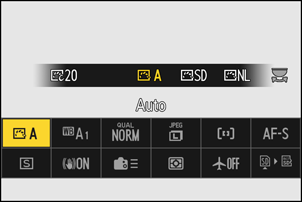
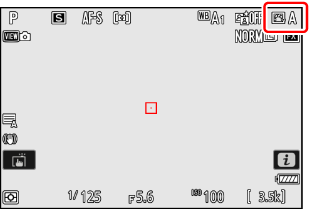
- The only options available when the photo/video selector is rotated to B&W are [Monochrome], [Flat Monochrome], and [Deep Tone Monochrome].
| Option | Description | |
|---|---|---|
| n | [ |
The camera automatically adjusts hues and tones based on the [Standard] (photo mode) or [Neutral] (video mode) Picture Control. |
| Q | [ |
Standard processing for balanced results. Recommended for most situations. |
| R | [ |
Minimal processing for natural results. Choose for pictures that will later be processed or retouched. |
| S | [ |
Pictures are enhanced for a vivid, photoprint effect. Choose for pictures that emphasize primary colors. |
| T | [ |
Take monochrome pictures. |
| 2 | [ |
Features gentle gradations from highlights to shadows, producing soft monochrome pictures. |
| 3 | [ |
Choose for slightly darker tones in the range from shadows to mid-tones, with brightness rapidly increasing as tones progress from mid-tones to highlights. |
| o | [ |
Smooth complexions for natural-looking portraits. |
| 4 | [ |
Produces more vivid results than [Portrait] while capturing details of the subject’s complexion and avoiding loss of detail in highlights. Choose for pictures that will later be processed or retouched. |
| p | [ |
Shoot vibrant landscapes and cityscapes. Choose for pictures that emphasize blues and greens. |
| q | [ |
Details are preserved over a wide tone range, from highlights to shadows. Choose for pictures that will later be extensively processed or retouched. |
k01–k20 |
Creative Picture Controls offer unique combinations of hue, tone, saturation, and other settings tuned for particular effects. Choose from a total of 20 options, including [Dream] and [Morning]. | |
- The [Set Picture Control] item in the video recording menu also offers a [Same as photo settings] option that sets the Picture Control for videos to the same as that used for photographs.
- The option selected for [Set Picture Control] takes effect when [SDR] is chosen for [Tone mode] in the photo shooting menu. To choose a Picture Control when [HLG] is selected for [Tone mode], use the [Set Picture Control (HLG)] item in the photo shooting menu.
Modifying Picture Controls
Picture Controls can be adapted to suit the scene or the photographer’s creative intent.
Select a Picture Control.
Select [Set Picture Control] in the photo shooting or video recording menu and then highlight the desired Picture Control and press 2.
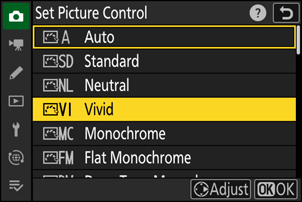
Adjust settings.
- Press 1 or 3 to highlight settings and 4 or 2 to choose a value. Each press increments the highlighted value by 1.
- The options available vary with the Picture Control selected.
- To quickly adjust levels for balanced [Sharpening], [Mid-range sharpening], and [Clarity], highlight [Quick sharp] and press 4 or 2.
- To abandon any changes and start over from default settings, press the O button.
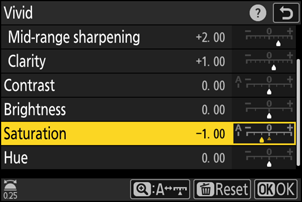
Save changes and exit.
Press J to save changes. Picture Controls that have been modified from default settings are indicated by an asterisk (“U”).
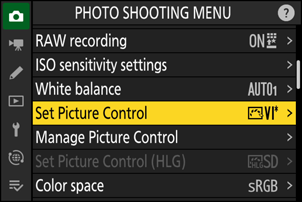
Picture Control Settings
| Option | Description | |
|---|---|---|
| [Effect level] | Displayed only when a Creative Picture Control is selected. Mute or heighten the effect of the selected Picture Control. | |
| [Quick sharp] | Apply sharpening to areas of contrast within the picture.
|
|
| [Sharpening] | Apply sharpening to small areas of contrast. | |
| [Mid-range sharpening] | Apply sharpening to areas of contrast larger than those affected by [Sharpening] and smaller those affected by [Clarity]. | |
| [Clarity] | Apply sharpening to large areas of contrast.
|
|
| [Contrast] | Adjust overall contrast. | |
| [Brightness] | Brighten or darken mid-tones (tones that fall in the range between highlights and shadows). The effect does not extend to highlights and shadows, ensuring that details in these areas of the image are preserved.
|
|
| [Saturation] | Control the vividness of colors.
|
|
| [Hue] | Adjust hue.
|
|
| [Filter effects] | Displayed only with [Monochrome], [Flat Monochrome], [Deep Tone Monochrome], and certain Creative Picture Controls. Simulate the effect of color filters on monochrome pictures. | |
| [Toning] | Displayed only with [Monochrome], [Flat Monochrome], [Deep Tone Monochrome], and certain Creative Picture Controls. Choose a tint for monochrome pictures. Choose from 9 different tints, including cyanotype and old-fashioned sepia.
|
|
| [Toning] (Creative Picture Controls) |
Displayed only with certain Creative Picture Controls. Choose the shade of color used. | |
The j indicator under the value display in the Picture Control setting menu indicates the previous value for the setting.

- Selecting the [A] (auto) option available for some settings lets the camera adjust the setting automatically.
- Results vary with exposure and the position of the subject in the frame.
Choose from the following [Filter effects]:
| Option | Description |
|---|---|
| [Y] (yellow) * | These options enhance contrast and can be used to tone down the brightness of the sky in landscape photographs. Orange [O] produces more contrast than yellow [Y], red [R] more contrast than orange. |
| [O] (orange) * | |
| [R] (red) * | |
| [G] (green) * | Green softens skin tones. Use for portraits and the like. |
The term in parentheses is the name of the corresponding third-party color filter for black-and-white photography.
Using “Filter Effects” with “Deep Tone Monochrome”
[Deep Tone Monochrome] features a strong built-in red filter effect that applies even when [OFF] is selected for [Filter effects]. Because [Filter effects] cannot be applied more than once, selecting an option other than [OFF] will disable the built-in red filter effect. Contrast can be reduced by enabling [Y], [O], and [R].
Settings can be adjusted in the range [A−2] to [A+2].

Highlighting [Set Picture Control] in the i menu and pressing J displays a Picture Control list. Highlight a Picture Control, press 3 to display options, and then edit settings while previewing the effect in the display.
- Press 1 or 3 to highlight settings. Press 4 or 2 to choose a value in increments of 1, or rotate the sub-command dial to choose a value in increments of 0.25.
- The options available vary with the Picture Control selected.
- To abandon any changes and start over from default settings, press the O button.
- Press J to save changes.
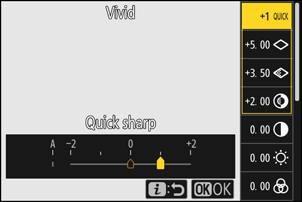
- Picture Controls that have been modified from default settings are indicated by an asterisk (“U”).
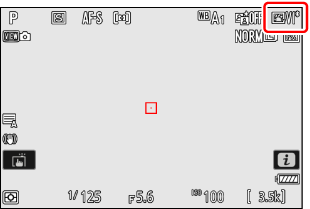
Custom Picture Controls
Save modified Picture Controls as custom Picture Controls.
| Option | Description |
|---|---|
| [Save/edit] | Create a new custom Picture Control based on an existing preset or custom Picture Control, or edit existing custom Picture Controls. |
| [Rename] | Rename custom Picture Controls. |
| [Delete] | Delete custom Picture Controls. |
| [Load/save] | Copy custom Picture Controls to and from a memory card. |
Creating Custom Picture Controls
Highlight [Manage Picture Control] in the photo shooting or video recording menu and press 2.
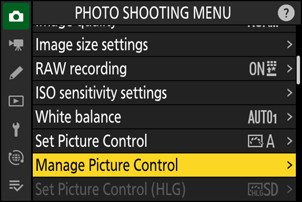
Select [Save/edit].
Highlight [Save/edit] and press 2 to view [Choose Picture Control] options.
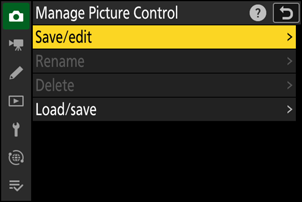
Select a Picture Control.
- Highlight an existing Picture Control and press 2 to display edit options.
- Note that the only Picture Controls available in black-and-white photo mode are [Monochrome], [Flat Monochrome], and [Deep Tone Monochrome].
- To save a copy of the highlighted Picture Control without further modification, press J. [Save as] options will be displayed; proceed to Step 5.
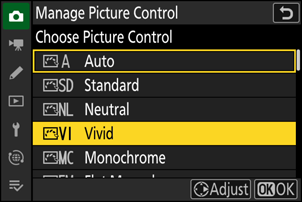
Adjust settings.
- The options and procedure are the same as for [Set Picture Control].
- Press J to display [Save as] options when settings are complete.
- To abandon any changes and start over from default settings, press the O button.
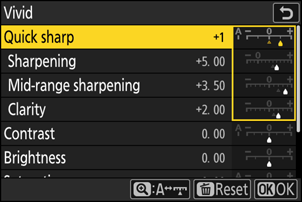
Select a destination.
Choose a destination for the custom Picture Control (C-1 through C-9).
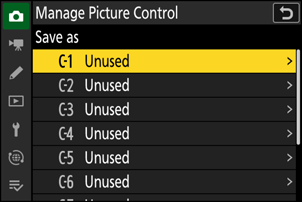
Name the Picture Control.
- Pressing 2 when a destination is highlighted in the previous step displays the [Rename] text-entry dialog.
- The default name, created by adding a two-digit number to the name of the existing Picture Control, appears in the text display area. The two-digit number is generated automatically by the camera.
- Custom Picture Control names can be up to nineteen characters long.
- For information on text entry, see “Text Entry” (0 Text Entry).
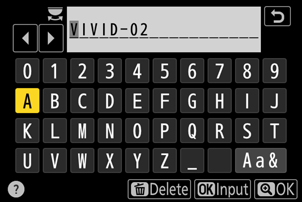
Press the X button.
- Text entry will end.
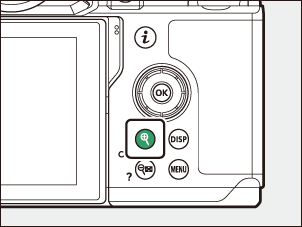
- The new Picture Control will be added to the Picture Control list.

The Original Picture Control Icon
The original preset Picture Control on which the custom Picture Control is based is indicated by an icon in the edit display.
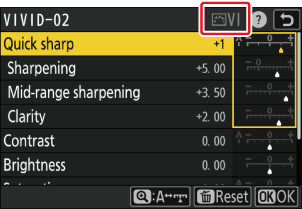
Custom Picture Control Options
The options available with custom Picture Controls are the same as those on which the custom Picture Control was based.
Sharing Custom Picture Controls
The [Load/save] item in the [Manage Picture Control] menu can be used to copy custom Picture Controls from the camera to a memory card. You can also delete custom Picture Controls or copy them from a memory card to the camera (the memory card must be inserted in the primary slot, as memory cards inserted in the slot designated as the secondary slot via [Primary slot selection] in the photo shooting menu will not be detected).
- [Copy to camera]: Copy (import) custom Picture Controls from the memory card to the camera. The Picture Controls are copied to custom Picture Controls C-1 through C-9 on the camera and can be named as desired.
- [Delete from card]: Delete selected custom Picture Controls from the memory card.
- [Copy to card]: Copy (export) a custom Picture Control from the camera to a memory card. Highlight a destination (1 through 99) for the selected Picture Control and press J to export it to a “CUSTOMPC” sub-folder, which will automatically be created under the “NIKON” folder on the memory card.
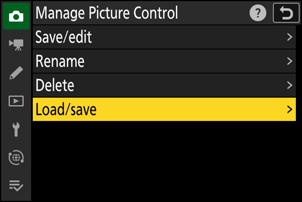
- Exported Picture Controls can be copied to another memory card using a computer. When copying Picture Controls to a memory card for import to the camera, be sure to save them to the card’s root (top) directory or to the “CUSTOMPC” folder under the“NIKON” folder.
